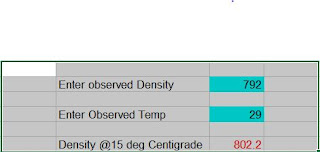An App for Calculation of Vapor pressure of Liquefied Petroleum (LP) Gases from Compositional Analysis based on D2598
The App is based on ASTM D2598 standard.
This Apps covers, by compositional analysis, the approximate
determination of Vapor pressure of commercial propane, special-duty propane,
commercial propane/butane mixtures, and commercial butane as per ASTM D2598
- Standard Practice for Calculation of Certain Physical Properties of Liquefied petroleum
(LP) Gases from Compositional Analysis.
The
composition of sample of LPG is obtained by using test method D2163 or other
acceptable method. From the analysis (expressed in liquid volume percent) the
vapor pressure at 37.8 C of the sample may be determined.
Steps :
a) Enter the Volume % of individual components of Gas. Ensure total % of all the gases is 100.
b) Read below in last cell - Vapor pressure of the sample.
a) Enter the Volume % of individual components of Gas. Ensure total % of all the gases is 100.
b) Read below in last cell - Vapor pressure of the sample.
 |
| Vapor pressure App - ASTM D2598 |
Conversion
of a compositional analysis from mole, gas volume or weight basis to liquid
volume can be obtained by using ASTM D2421 or other suitable method.
Vapor
pressure is an important specification of commercial propane, special duty propane,
propane/butane mixtures and commercial butane that assure adequate
vaporisation, safety and compatibility with commercial appliances.
Report
the vapor pressure value calculated after rounding to the nearest multiple of 7
kPa g as LP-gas vapor pressure of the sample, kPa gage at 37.8°C (100°F).
You can see other Apps of LPG based on ASTM D2598 at following:
An Apps for Calculation of Relative Density of Liquefied Petroleum (LP) Gases from Compositional Analysis based on ASTM D2598.
rjpatelioc2014@gmail.com
Follow me on twitter @RJPatel13 to get notification when my new post is available in my blog.
Follow me on twitter @RJPatel13 to get notification when my new post is available in my blog.
Keywords – propane, butane,
physical properties, liquified petroleum gases, LPG, vapor pressure.


Comments